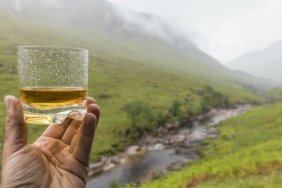It must’ve been while sipping Glenlivet 18-year single malt Scotch Whisky in a castle, in a kilt, watching a Scottish snowstorm in May, that I fully realized the depth of unparallelled privilege I was immersed in. On a recent press trip to the Speyside region of Scotland with The Glenlivet, the discovery and adventure were matched only by the quality and impression of the spirits we traveled over 5,000 miles to sample at the source.
Tales of taking part in the judging and awards ceremony of the Speyside Whisky Festival, touring the region’s historic distilleries, pouring our own 16-year Aberlour whisky, staying in the master bedroom of Gordon castle and beyond are in impatient abundance to be told, but one particular experience bears standing alone in the telling: our journey along The Glenlivet Smugglers Trails in the hills of Speyside.
Scotch Whisky aficionados don’t cap their reverence on the quality of the single malt they’re drinking, but rather relish the story that accompanies the spirit, whether through production, the history of the distillery or the lore of the countryside from where it came. In the early 19th century, private distillation of whisky was illegal while permitted whiskymaking was strictly regulated, but rogue distillers thrived in the rugged Scottish Highlands throughout the era, ensuring that the art of fine distillation persevered through social mores and restrictive laws. Whisky smugglers of the past, eager to avoid the watchful eye of regulators and taxing excisemen, would move their goods over rugged highland passes to outer markets such as Aberdeen and Edinburgh. The origins of a majority of existing distilleries in the Speyside region today are rooted in the illicit trade, and is a source of soaring pride among both those in the industry and the fortunate folk enjoying the fine product.
Led by Master Distiller Alan Winchester, an esteemed 34-year veteran of the Speyside whisky industry with a ten-thousand jigawatt smile and impossibly warm disposition through his thick highland brogue, our group headed off to retrace the nearly two-centuries-old steps of smugglers and bootleggers on the 11km trail (just under 7 miles) from The Glenlivet Distillery. Through spotty fits of hail and temperatures that would routinely plummet without warning, we trekked past the ruins of Glenlivet founder George Smith’s original distillery in Upper Drumin, as well as Josie’s Well, the mineral-rich natural spring from which 3,500 gallons of pure water flows hourly – a crucial element in making the whisky.

King George IV had a particular taste for Smith’s whisky and granted him a license in 1824, establishing The Glenlivet, which would become the second-largest Scottish malt whisky in the world (and the largest in America). A legend in his own right, Smith was notoriously envied by peers and former colleagues in the illicit trade, and was known to have carried – and slept with – loaded pistols for protection (the pistols – gifts from the Laird of Aberlour – are on display today in the Glenlivet Distillery). Hostile rival whisky smugglers threatened his business at every turn, and coupled with the harsh terrain creativity was essential on both sides, a deadly game of pursuit and sabotage raged between peetreekers (illicit distillers) and gaugers (excisemen) alike.
Exposed to merciless elements, the Speyside landscape is peppered with ruins of croft cottages that possessed the framework of the area’s illicit distilling, once hosting more than 200 stills at its peak point of production. Hiding their goods amongst the thatches of heather, the bootleggers burned smoke-free juniper bushes rather than peat – a terrific way to avoid detection by the observing eyes. Transportation of their wares was the tricky part, of course, and the result was the establishment of a network of trails threading through the hills.
The smugglers’ trails are now marked for hiking, though the paths are by no means casual nature trails. Boots are recommended for walking through the countryside, a good portion of which amounts to a nearly frozen bogland where weak ankles can snap like twigs amongst the rivets and moist, uneven landscape rife with peaty soil. A few ill-decided steps into our trip and I was soaked to the knees. Truly, high ground is the only way to stay dry.
When we came at last to the summit of Cairn Daimh the grand promises of beauty were at once rendered flaccid, silly understatements at best. Once we reached the top of the mountain, the heart rate reducing to a less extreme machine gunfire, the full view of the Scottish countryside was unveiled. As far as the eye could see in every direction was a breathtakingly gorgeous landscape of pasture-rich and rocky terrain, steep hills and distant mountain peaks.

The chill of the eastbound winds rushing up the mountainside filled our lungs like tiny icicles as we adapted to the altitude, and it wasn’t long before a bottle of the 18-year made its way into the rounds for a celebratory toast. After savoring the honey and delicate floral notes to the aged spirit, its long and gently warming finish made for the perfect touch to a day spent hiking through the land of its making.
Upon return from the five-hour trek down MacPherson Trail, we were greeted back at The Glenlivet with an invite to taste a dram from the smallest working legal still in Scotland. Though tiny, the still is no slouch on function and left a fine finish on our experience in the countryside.
For whisky aficionados and adventurers looking to retrace the steps of exhilarating history, the Glenlivet Smugglers Trails tour is a perfect highlight to your pilgrimage to the motherland of whisky.







